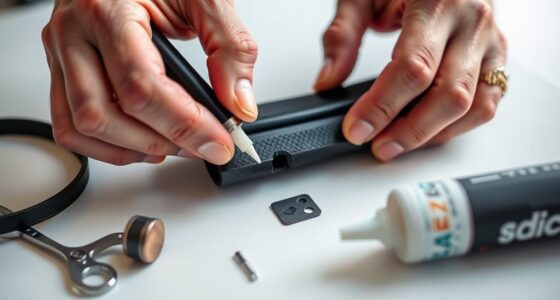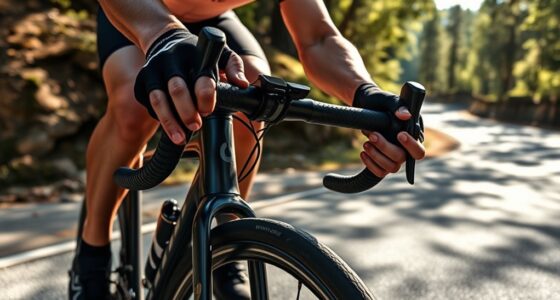When choosing the perfect cycling helmet in 2025, look for safety certifications like CPSC or NTA-8776, especially if you ride eBikes. A good fit is essential—measure your head for size and make certain straps create a snug V shape. Consider construction materials, ventilation, and comfort features that suit your riding style. Don't forget smart features like lights or crash detection. Want tips on specific helmets and care routines? Keep exploring to discover more insights!
Key Takeaways
- Ensure the helmet meets safety standards like CPSC, EN 1078, or NTA-8776, especially for eBike riders needing enhanced protection.
- Choose a helmet that fits snugly, with adjustable straps to accommodate different head shapes for maximum comfort and safety.
- Look for advanced construction materials like polycarbonate shells and EPS foam liners, which provide durability and impact absorption.
- Consider smart features such as integrated lights, Bluetooth connectivity, and crash detection for added safety and convenience during rides.
- Regularly inspect and maintain your helmet, replacing it every 3-5 years or after any significant impact for optimal protection.
Essential Factors in Bicycle Helmet Selection
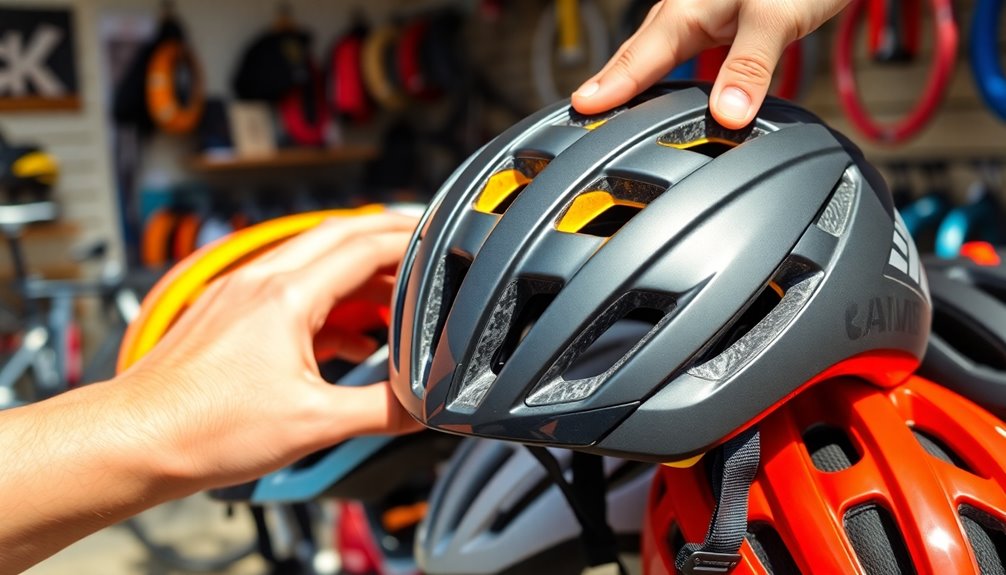
When selecting a bicycle helmet, it's vital to prioritize safety and comfort. Start by ensuring the helmet meets safety certifications like CPSC, EN 1078, or NTA-8776 for eBike use, which offers better impact protection.
The fit is essential; measure your head circumference about an inch above your eyebrows, ensuring the helmet sits level and straps form a snug V shape under your ears.
Don't overlook ventilation—adequate airflow keeps you comfortable during long rides, especially in warmer weather. Look for helmets featuring MIPS technology to reduce rotational forces during impacts and integrated lights for enhanced visibility.
Finally, consider lightweight options that provide excellent protection while minimizing fatigue on extended cycling adventures.
Understanding Bicycle Helmet Construction
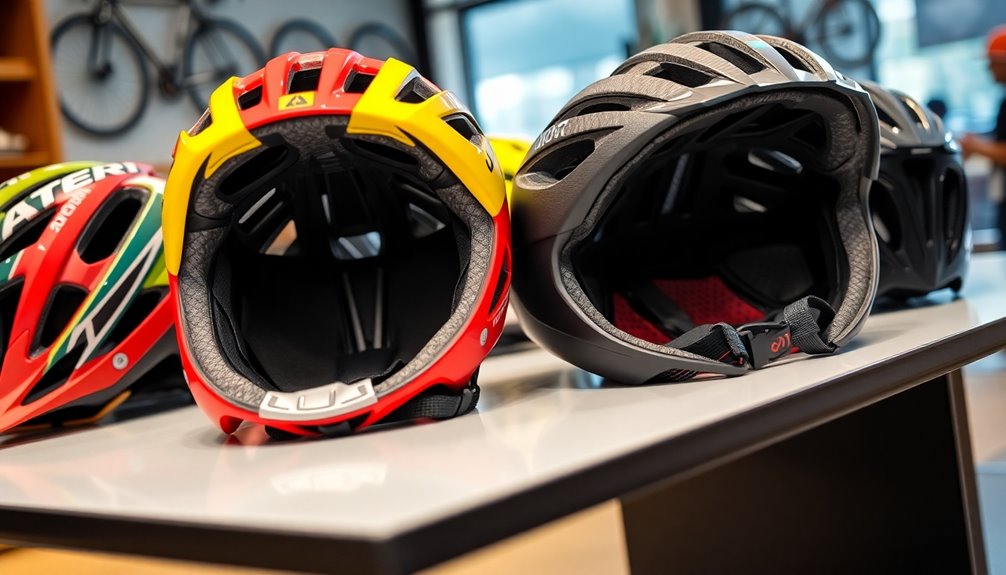
Bicycle helmets blend safety and innovation through their thoughtful construction.
The outer shell, often made from durable materials like polycarbonate, is designed to crack on impact, dissipating energy to protect your head. Inside, impact-absorbing liners, typically constructed from EPS foam, compress during a collision, effectively reducing the force transmitted to your skull.
Bicycle helmets feature durable outer shells that crack on impact, complemented by EPS foam liners that absorb and reduce collision forces.
Some helmets even use advanced materials like expanded polypropylene (EPP) for added durability against multiple impacts. To guarantee a snug fit, helmets feature a reliable retention system with adjustable straps and dials, preventing any movement while you ride.
Additionally, effective ventilation systems enhance airflow, keeping you cool and comfortable during long bike rides.
All these elements come together to provide superior protection and safety features you can trust.
Specific Features for Different Cyclists

When choosing a helmet, you should pay attention to safety certifications, as these guarantee you're protected on the road or trail.
Smart features, like integrated lights and turn signals, can enhance your visibility and safety, especially for commuters.
Understanding these elements can help you pick the perfect helmet tailored to your riding style.
Safety Certifications Importance
Choosing the right cycling helmet goes beyond personal preference; it directly impacts your safety on the road or trail. Safety certifications like CPSC, EN 1078, and NTA-8776 guarantee helmets meet specific impact protection standards. For instance, NTA-8776 is vital for eBike riders due to its higher-speed protection. Helmets with MIPS technology further enhance safety by reducing rotational forces during impacts, which is significant for competitive cyclists.
| Certification | Best For | Specific Features |
|---|---|---|
| CPSC | Recreational | General impact protection |
| EN 1078 | Road Cycling | Lightweight, aerodynamic |
| NTA-8776 | eBike Riding | High-speed impact protection |
| MIPS | Mountain Biking | Rotational force reduction |
Be certain to check the coverage area as well, especially around vulnerable areas like your temples.
Smart Features Necessity
As cycling evolves, incorporating smart features into helmets has become essential for enhancing safety and connectivity.
For urban cyclists, integrated lights and turn signals boost visibility, especially in low-light conditions. If you ride in groups, helmets with Bluetooth connectivity allow hands-free communication and navigation, keeping you connected without distractions.
For solo riders, crash detection and SOS alerts linked to your smartphone provide peace of mind, ensuring quick emergency responses. App integration enhances your experience with features like brake detection, forming a seamless cycling ecosystem.
If you're considering eBike helmets, look for NTA-8776 certification, as it emphasizes advanced impact protection, vital for higher-speed riding.
Embracing these smart features makes your cycling safer and more enjoyable.
Caring for Your Helmet
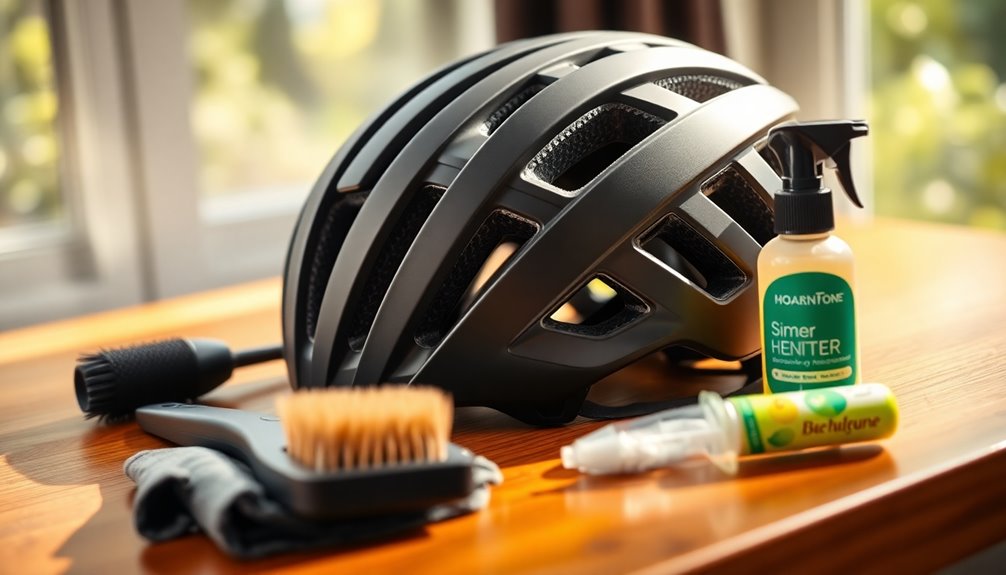
Taking care of your helmet is essential for your safety and comfort.
Make it a habit to inspect it regularly for any damage, and don't forget to clean the interior and exterior to keep it fresh.
Keeping your helmet in top shape guarantees it'll protect you when you need it most.
Regular Inspection Practices
To guarantee your cycling helmet remains effective, it's crucial to conduct regular inspections. This helps confirm your safety while riding. Here's what you should check:
- Inspect for Cracks and Dents: Look for any signs of impact damage. Even minor issues can compromise safety.
- Check Straps and Buckles: Examine these components for fraying or wear. Damaged retention systems can affect fit and effectiveness.
- Clean and Store Properly: After rides, clean your helmet with mild soap and water. Store it in a cool, dry place, away from direct sunlight to prevent UV damage.
Remember to replace your helmet every 3-5 years or after any significant impact to maintain adequate protection. Regular inspection is key to confirming your helmet stays safe and effective. Additionally, keeping your helmet in good condition can enhance your self-perception and confidence while riding.
Battery Maintenance Tips
After verifying your helmet's physical integrity through regular inspections, it's time to shift focus to its battery maintenance.
To maintain battery life, store your smart helmet indoors, away from extreme temperatures that can affect performance. Charge the helmet when the battery level drops to around 20% to prolong its overall battery life and guarantee consistent functionality.
Regularly inspect for signs of wear and tear, especially around the battery and charging port, to ensure safe usage.
Also, keep your helmet updated by checking for software updates via the companion app; perform these updates after rides to avoid potential issues.
Finally, clean the helmet with mild soap and water, steering clear of harsh chemicals that could damage the battery or electronic components.
Budget Considerations

When it comes to choosing a cycling helmet, budget considerations play a crucial role in your decision-making process. Cycling helmets vary greatly in price points, with quality helmets ranging from $30 for budget helmets to over $300 for premium helmets featuring advanced features.
Here's what to keep in mind:
- Safety Standards: Verify your helmet meets CPSC or EN 1078 safety standards, even if you opt for a budget option.
- Investment in Quality: A well-fitted helmet can greatly reduce the risk of head injuries, making it worth the investment.
- Look for Discounts: Many brands offer discounts and promotions to help balance your budget with your desired features.
Tips for Buying the Perfect Helmet

Choosing the right cycling helmet can feel overwhelming, especially with so many options available. Start by checking for safety certifications like CPSC or EN 1078, ensuring the helmet provides adequate protection.
Next, measure your head circumference to find a proper fit. A snug fit enhances safety and comfort, so try on several models.
Don't overlook ventilation features; multiple vents will keep you cool during long rides in hot conditions. If you ride frequently, consider smart features such as integrated lights or turn signals to enhance visibility.
Finally, analyze your budget—premium helmets offer advanced technology, but plenty of affordable options meet essential safety standards.
Prioritize what matters most for your riding conditions and enjoy every ride!
Frequently Asked Questions
How to Choose a Good Cycling Helmet?
When you're choosing a good cycling helmet, start by ensuring it meets safety certifications like CPSC and EN 1078.
Measure your head circumference for a proper fit, making sure the helmet sits level and covers your forehead.
Look for smart features like integrated lights for visibility and check ventilation for comfort during long rides.
Finally, opt for adjustable sizing systems to fine-tune the fit and avoid pressure points.
What Is the 2 2 2 Rule When Fitting a Helmet on Your Head?
Picture yourself gearing up for a ride, the sun shining above.
To guarantee your helmet fits just right, follow the 2 2 2 rule.
First, make sure there are two finger widths between the helmet and your eyebrows.
Next, fit two fingers under the chin strap for comfort.
Finally, adjust the side straps so they form a "V" shape just below your ears.
This guarantees safety, comfort, and a snug fit as you ride.
How Many Years Is a Bike Helmet Good For?
A bike helmet's lifespan is generally 3-5 years, even if you haven't had a crash.
You should replace it immediately after any significant impact, regardless of visible damage.
Regularly check for cracks, dents, or frayed straps, as these can indicate it's time for a new helmet.
Is a 10 Year Old Helmet Still Good?
Imagine riding a bike with a helmet that's as outdated as a flip phone. A 10-year-old helmet isn't good anymore.
Technology's advanced, and materials can degrade, leaving it less effective in protecting your head. Most manufacturers suggest replacing helmets every 3-5 years.
Even if the helmet looks fine, it mightn't meet current safety standards. For your safety, it's best to invest in a newer model that offers proper protection.
Conclusion
In choosing your perfect cycling helmet, remember that it's not just about style; it's about safety and fit. Coincidentally, while you're picking out that sleek design, consider the construction and features tailored to your riding style. You might find that a helmet designed for road cycling unexpectedly suits your weekend adventures too. So, invest wisely, care for your helmet, and embrace the ride—because the right gear can turn an ordinary journey into an extraordinary experience.


